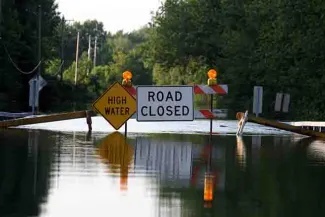
EarthTalk - Do floodwaters contain toxic chemicals?
© iStock
Dear EarthTalk:
In the aftermath of flood, we often hear about the immediate dangers of rising waters—drowning, swift currents and submerged vehicles. But what about the less visible threats? Specifically, do floodwaters contain toxic chemicals?
Wil Hanson, Huntington, CT
Floodwaters are indeed treacherous, and their murky depths harbor more than just debris and silt. While the immediate risks of drowning and physical injury are apparent, the invisible hazards lurking within floodwaters can pose long-term health threats.
One of the unseen dangers in flooding is chemical contamination. Floodwaters aren’t merely brown from dirt; they can also carry a cocktail of noxious pollutants. These contaminants originate from various sources. Household waste from cleaning agents, pesticides and other household chemicals can seep into floodwaters. In industrial zones, toxic gases like methane and sulfur dioxide may escape. Also, industrial chemicals like benzene and butadiene—known carcinogens—can get into the water. Agricultural fertilizers, pesticides and liquid waste from farms also get in to the chemical soup. And as floodwaters scour soil and backyards, they unearth heavy metals like lead, mercury, and cadmium. These can persist in the water, posing risks to human health. In regions near coal-fired power plants, floodwaters may carry coal ash waste. This waste contains carcinogenic compounds like arsenic, chromium and mercury.
Besides outright pollutants, floodwaters contain bacteria and lead to wound infections. If you have cuts or abrasions, wash them with soap and clean water. Also, floodwater can cause skin rashes and irritation. Swallowing or coming into contact with contaminated water can lead to stomach ailments. Puncture wounds or those contaminated with feces need prompt attention. Tetanus boosters may be necessary. Less common but worrisome are Leptospirosis and Melioidosis, bacterial infections that can occur after exposure to contaminated water.

© iStock - djperry
The most important thing to do is to stay out of floodwater whenever possible. If you come into contact with floodwater, wash the affected area with soap and clean water. Launder clothes contaminated by flood or sewage water in hot water and detergent. If you must enter floodwater, wear rubber boots, gloves and goggles. Also bear in mind that floodwaters may hide sharp objects, so be cautious to prevent injuries.
Many of us will be faced with floodwaters as global warming increases and causes more frequent and stronger storms. “Changes in the environment have already increased flooding across the United States, particularly in coastal and low-lying areas,” reports the non-profit First Street, which created an online tool that makes it easy for Americans to find their home’s risk. “As these trends continue into the future, 8.2 million more Americans will be at risk, and the damage and cost of flooding will continue to add up.”
Indeed, floodwater is more than just a murky inconvenience—it carries a hidden burden of toxins. Remember: Even when the waters recede, the risks may linger for months. If your region is vulnerable, make sure you know how to keep yourself and loved ones safe in the event of a flood where you live.
CONTACTS
- First Street National Flood Risk Assessment, https://firststreet.org/research-library/the-first-national-flood-risk-assessment;
- Floodwater After a Disaster or Emergency, https://www.cdc.gov/disasters/floods/floodsafety.html;
- How Toxic Are Flood Waters? https://daily.jstor.org/how-toxic-are-flood-waters/.
EarthTalk® is produced by Roddy Scheer & Doug Moss for the 501(c)3 nonprofit EarthTalk. See more athttps://emagazine.com. To donate, visit https://earthtalk.org. Send questions to: question@earthtalk.org.
















